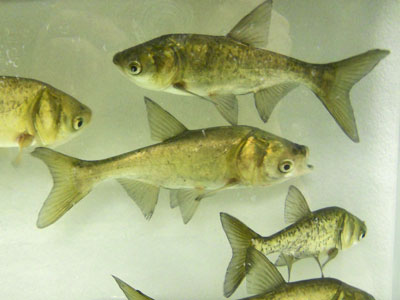In January 2021, scientists, engineers, and contractors will begin installing a temporary, experimental underwater Acoustic Deterrent System, or uADS, at Mississippi River Lock and Dam 19 between Keokuk, Iowa, and Hamilton, Illinois.
The construction is part of a study to understand how invasive Asian carp respond to acoustic, or sound, signals.
Asian carp, including silver carp, bighead carp, black carp, and grass carp, are harmful because they grow quickly and aggressively compete with native fish for food and habitat.
The U.S. Geological Survey, the U.S. Army Engineer Research and Development Center and partners will install the experimental uADS in the lock approach to test, under field conditions, the potential for acoustic signals to deter Asian carp and native fishes from moving upstream.
The test will help researchers understand and assess the engineering, maintenance and logistical considerations associated with long-term operations of a uADS in an active navigation channel.
If the deterrent is effective at controlling upstream movement of Asian carp with limited effects on native species, this or similar technology could be deployed at other critical locations to help prevent the spread of invasive Asian carp.
Like many fish species, Asian carp use navigation locks to bypass dams and move upstream in rivers for reproduction or to extend their range.
Structures like Lock and Dam 19, over which fish cannot pass, force the fish to traverse the lock, making the navigation lock and its approach ideal areas to place control technologies to deter upstream fish movement.
Lock 19 is a particularly useful test site because scientists previously studied movements of native fish and Asian carp around and through this lock.
The equipment installation is scheduled concurrent with planned lock maintenance from Jan. 1 to March 15, 2021. The Army Corps of Engineers will close the navigation lock during this maintenance period.
Construction and installation of the uADS and study equipment will likely last about two months, and then the uADS will operate for up to three years, according to a research study plan.
Boaters near the deterrent may hear the signal through the hull of their vessels. The low sound levels in air will not be hazardous to people and will not interfere with high-frequency sonar, communications equipment or similar electronics.
This multi-agency study is led by the USGS in collaboration with the U.S. Army Engineer Research and Development Center; the Army Corps of Engineers – Rock Island District, which operates Lock 19, and Chicago District; the U.S. Fish and Wildlife Service; the Illinois Department of Natural Resources; the Iowa DNR; the Minnesota DNR; the Missouri Department of Conservation and the Wisconsin DNR.
For more information on Asian carp research, visit the USGS Upper Midwest Environmental Sciences Center website (https://www.usgs.gov/centers/umesc/)
